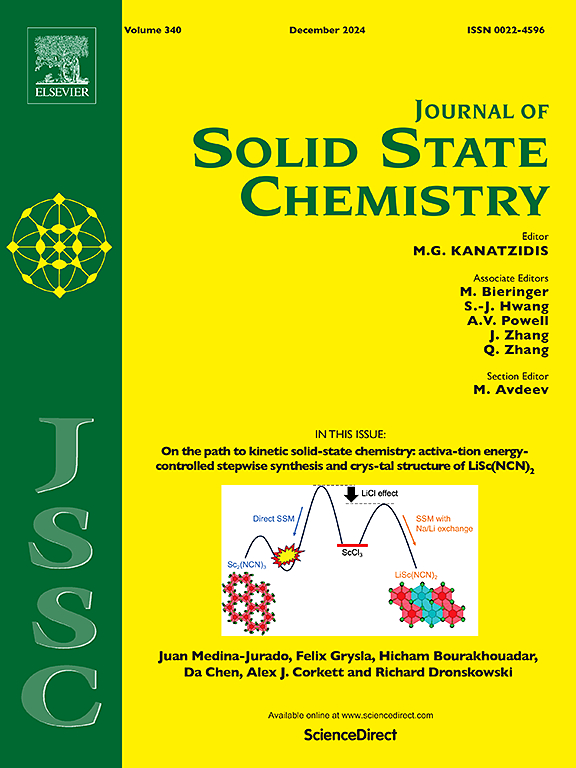Structural characterization of two manganese (II) phosphite-oxalate coordination polymers: Water-assisted proton conductivity and transport mechanism
IF 3.2
3区 化学
Q2 CHEMISTRY, INORGANIC & NUCLEAR
引用次数: 0
Abstract
Using N, N′-dimethylpiperazine (Me2ppz; C6H14N2) as structure directing agent, two new manganese phosphite-oxalate compounds with different dimensions namely, {[Mn(H2PO3)(C2O4)](H2Me2ppz)0.5·H2O}n (1) and {[Mn2Cl(H2O)(H2PO3)2(C2O4)1.5](H2Me2ppz)}n (2), were prepared under solvothermal and solvent-free conditions, respectively. Structural analyses reveal that 1 displays a 3D framework with intersecting channels, while 2 shows a layer structure with 12-membered ring (MR) windows. For 1, the free water molecules acting as proton carriers to help for proton transport are located in the intersecting channels and interact with the host framework by hydrogen bonds. Furthermore, compound 1 displays a high proton conductivity of 2.63 × 10−3 S cm−1 at 75 °C and 98 % relative humidity, attributed to its continuous H-bond networks providing effective proton conduction pathways. The proton transport mechanism was further investigated through the integration of crystal structural analysis, H2O vapor adsorption data and activation energy value.
两种磷酸锰草酸配位聚合物的结构表征:水辅助质子电导率和传输机制
使用N, N ' -二甲基哌嗪(Me2ppz;以C6H14N2为结构导向剂,分别在溶剂热和无溶剂条件下制备了两种不同尺寸的新型磷酸锰-草酸盐化合物{[Mn(H2PO3)(C2O4)](H2Me2ppz)0.5·H2O}n(1)和{[Mn2Cl(H2O)(H2PO3)2(C2O4)1.5](H2Me2ppz)}n(2)。结构分析表明,图1显示了具有相交通道的三维框架,而图2显示了具有12元环(MR)窗口的层状结构。对于1,作为质子载体帮助质子运输的自由水分子位于交叉通道中,并通过氢键与宿主框架相互作用。此外,化合物1在75°C和98%相对湿度下表现出2.63 × 10−3 S cm−1的高质子电导率,这归功于其连续的氢键网络提供了有效的质子传导途径。结合晶体结构分析、水蒸汽吸附数据和活化能,进一步研究了质子输运机理。
本文章由计算机程序翻译,如有差异,请以英文原文为准。
求助全文
约1分钟内获得全文
求助全文
来源期刊

Journal of Solid State Chemistry
化学-无机化学与核化学
CiteScore
6.00
自引率
9.10%
发文量
848
审稿时长
25 days
期刊介绍:
Covering major developments in the field of solid state chemistry and related areas such as ceramics and amorphous materials, the Journal of Solid State Chemistry features studies of chemical, structural, thermodynamic, electronic, magnetic, and optical properties and processes in solids.
 求助内容:
求助内容: 应助结果提醒方式:
应助结果提醒方式:


